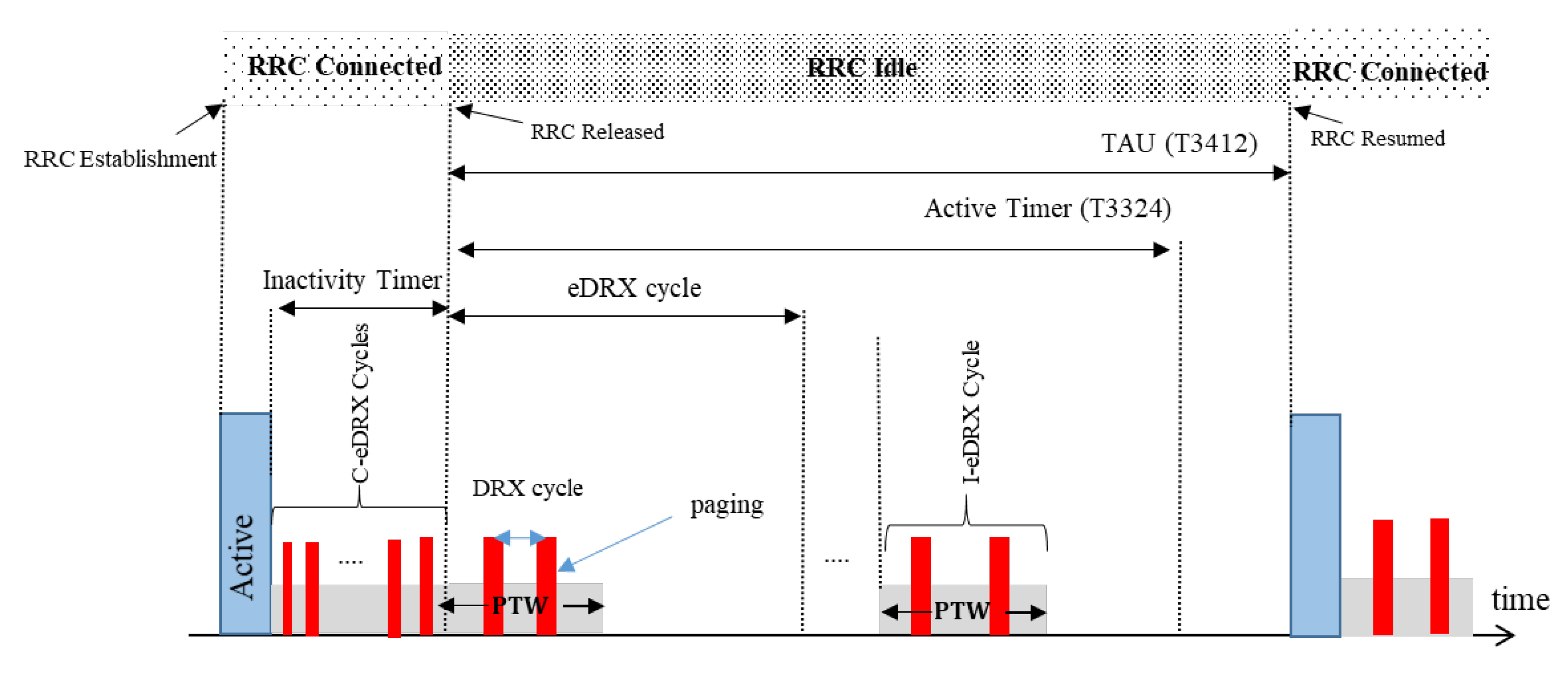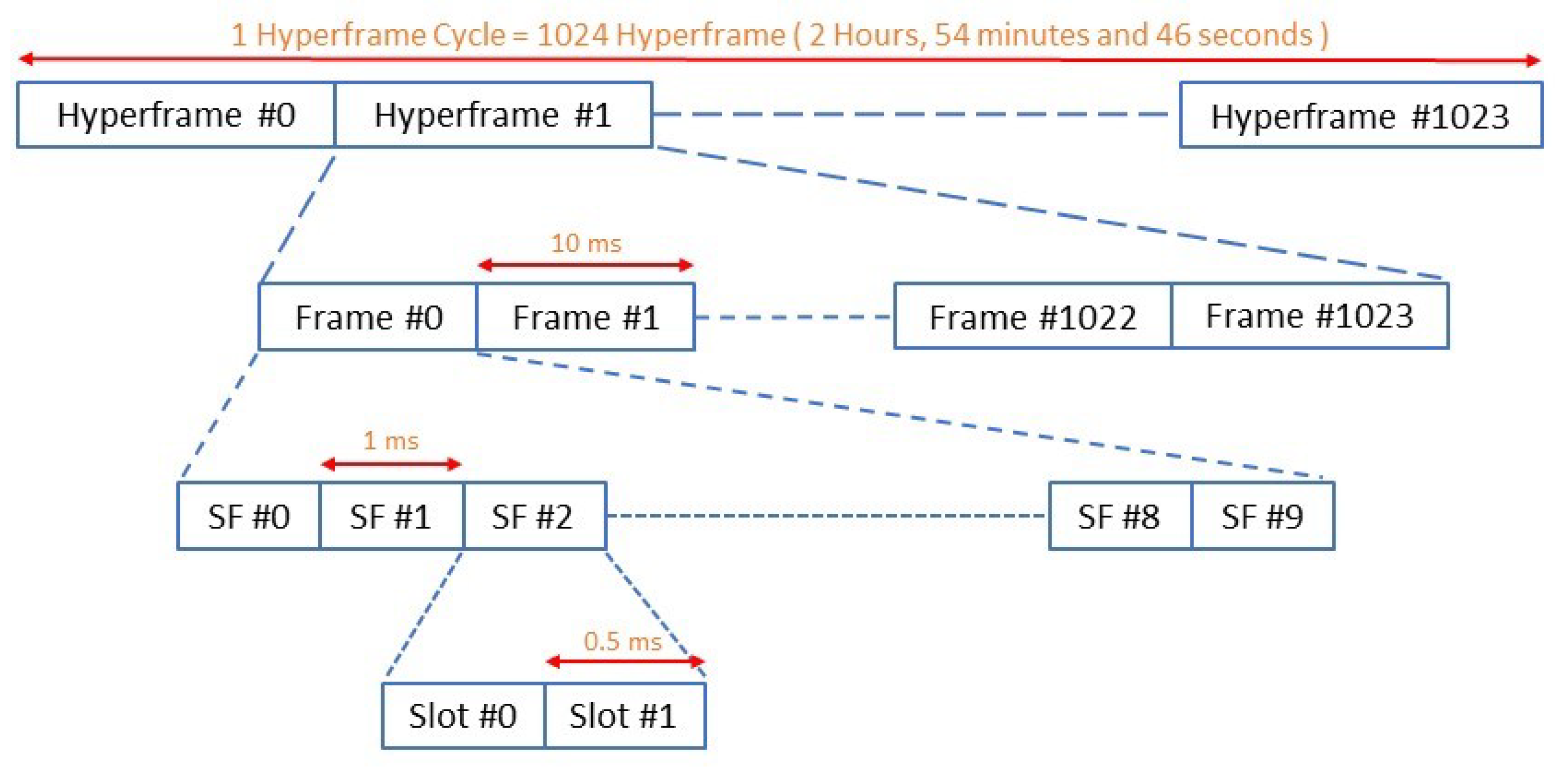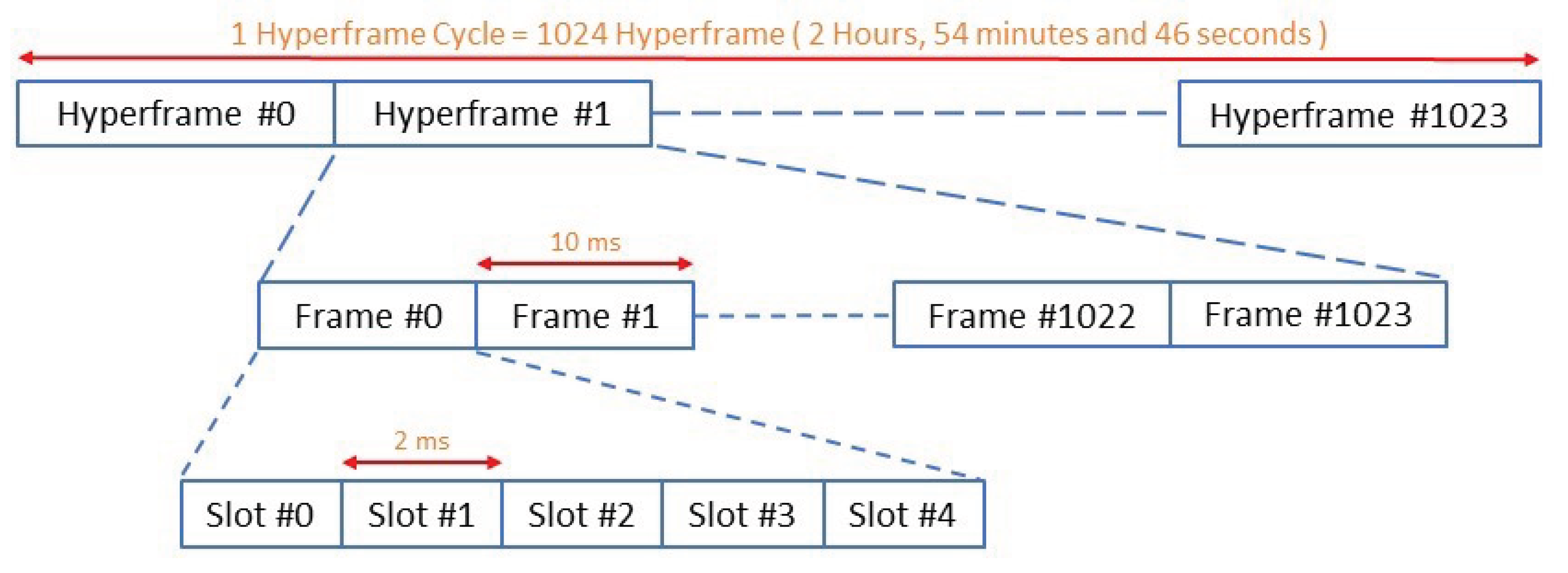You're using an outdated browser. Please upgrade to a modern browser for the best experience.
Please note this is a comparison between Version 2 by Rita Xu and Version 1 by Ren-Hung Hwang.
Narrowband Internet of Things (NB-IoT) is one of the low-power wide-area network (LPWAN) technologies that aim to support enormous connections, featuring wide-area coverage, low power consumption, and low costs. NB-IoT could serve a massive number of IoT devices, but with very limited radio resources. Therefore, how to enable a massive number of IoT devices to transmit messages periodically, and with low latency, according to transmission requirements, has become the most crucial issue of NB-IoT.
- 5G
- NB-IoT
- uplink scheduling
- resource units
- power saving mechanism
1. Introduction
Many Internet of Things (IoT) devices are available on the market; the so-called Internet of Everything (IoE) is becoming a trend [1,2][1][2]. Thanks to the availability of low cost, high speed, and highly reliable 5G cellular networks, people can purchase IoT devices and utilize them as per their needs [3,4,5,6][3][4][5][6]. However, different types of IoT devices have different transmission frequencies and reporting rates. Various telecom operators provide various tariff plans for their IoT device services. In narrow band Internet of Things (NB-IoT), the uplink data are transmitted through a narrowband physical uplink shared channel (NPUSCH), with limited transmission resources. Using Release 15 as an example, in reality, the highest uplink transmission rate is less than 200 kbps [7[7][8][9],8,9], and a large amount of flooded traffic at the same time will make NPUSCH very congested. Moreover, before a connection is established between user equipment (UE) and the evolved node-B or ’eNB’, a random-access procedure is required. After the random-access procedure is completed, all UE will need an appropriate uplink scheduling algorithm to transmit data to eNB with low latency in a power-saving mode (PSM). For this reason, wresearchers propose the persistent periodic uplink scheduling algorithm (PPUSA) to achieve energy-saving uplink scheduling.
With the use of the PPUSA algorithm, for UE, there can be a guarantee of uplink transmission periodically, without congestion in the uplink channel. The algorithm that is proposed in this paper will estimate the traffic demand of each type of UE to be uploaded to the base station based on the tariff flow and the data transmission characteristics of typical IoT devices. Generally speaking, the deployment of UE is carefully planned, so it will not transmit more than its subscribed traffic and will reserve a certain percentage of traffic for emergency use. The proposed PPUSA algorithm is designed to customize the upload schedule for the UE after taking into account the above considerations, which achieves power-saving and low-latency transmission and enables the entire NB-IoT system to cope with tens of thousands of uplink transmissions of IoT devices.
The novelty and contributions of this paper are summarized as follows. Firstly, this paper studies the e NB-IoT uplink scheduling for a massive number of IoT devices, which receives less attention in the literature. Secondly, this paper proposes a a novel uplink scheduling algorithm to solve the problem of transmitting messages with low latency in NB-IoT when there are many IoT devices, and each device demands that its sensing messages be transmitted in a periodic manner. In addition, each device may occasionally have emergency messages to send. Thirdly, the proposed novel scheduling mechanism guarantees that the device wakes up to transmit immediately in order to minimize transmission delay and power consumption. Finally, the proposed scheduling algorithm can support up to 600,000 IoT devices when the NB-IoT uplink utilization is 80%. In addition, it takes only one millisecond for the transmission of the emergency messages.
2. Background and Related Works
2.1. About NB-IoT
NB-IoT was proposed by 3GPP to support a wide range of cellular devices and services. NB-IoT standard is one of the mainstream low power wide area network (LPWAN) technologies. The primary focus of NB-IoT involves its indoor coverage, long battery life, low cost, low power consumption, high connection density, and high throughput characteristics. NB-IoT has the unique feature to co-exist with 2G GSM systems, as well as with 4G LTE systems. Three operation modes, namely the in-band operation mode, guard-band operation mode, and stand-alone operation mode, respectively, are present in NB-IoT systems. Similar to LTE, NB-IoT adopts orthogonal frequency division multiple access (OFDMA) technology for downlink transmission with 15 kHz sub-carrier spacing. In uplink transmission, NB-IoT utilizes single-carrier frequency division multiple access (SC-FDMA) technology with 15 and 3.75 kHz spacing to support single-tone (sub-carrier) and multi-tone transmissions, respectively [10]. Table 1 depicts the technical parameters for the NB-IoT standard [11].Table 1. Technical Parameters NB-IoT.
| Parameters | Technical Features |
|---|---|
| Frequency | Licensed LTE frequency |
| Bandwidth | 180 kHz |
| Modulation |

Figure 4. eDRX-MODE.
2.2. Uplink Scheduling for NB-IoT
When the base station wants to schedule an uplink transmission of the user equipment (UE), the base station sends a downlink control information (DCI) to one of the NPDCCH search spaces monitored by the UE. In order to distinguish the UE, the system assigns different radio network temporary identifiers (RNTI) to different UE, and the base station uses these RNTIs to encode the CRC bits of the DCI. Therefore, only the UE that knows the corresponding RNTI can successfully decode, and after decoding, the relevant information about the uplink schedule can become available. There are many types of DCI, among which, the DCI-format-N0 is used for uplink scheduling [16,17][16][17]. For uplink data transmission, the UE needs a time gap of at least 8 milliseconds to switch from receiving the DCI mode to the transmission mode. This time gap, also called scheduling delay, is designed for the UE to decode DCI. After the UE completes the NPUSCH uplink transmission, a time gap of at least 3 milliseconds is required to allow the UE to switch from the transmission mode to the receiving DCI mode to receive the ACK/NACK, and monitor the next NPDCCH search space, as shown in Figure 5.
Figure 5. Uplink data transmission.
2.3. Literature Review of Uplink Scheduling
The NB-IoT system supports single-tone (3.75 kHz) transmission and multi-tone (15 kHz) transmission for uplink scheduling. NB-IoT can be deployed in-band, utilizing resource blocks within a regular LTE carrier, in the unused resource blocks within an LTE carrier’s guard-band, or standalone for deployments in a dedicated spectrum. However, wresearchers cannot directly apply the LTE uplink scheduling mechanism to NB-IoT because the LTE’s semi-persistent scheduling (SPS) [18] is dedicated to periodic data transmissions, such as voice over IP (VoIP) services. Therefore, the existing LTE SPS configuration is only for a single UE. Moreover, in [19], the authors propose a group-based uplink scheduling algorithm, where they group the devices first and then select a group leader in each group. Next, the base station determines which group transmits first according to the environment of each group leader. However, this approach only schedules a single device. In [20], the authors design a scheduler to arrange wireless resources for NB-IoT resource allocation. However, the scheduler is designed to comply with 3GPP Release 13 and cannot support single-tone and multi-tone transmissions. The work [21] proposes an adjustable uplink resource scheduling scheme, but the scheme only addresses scheduling for emergency needs and does not meet the NB-IoT specifications. In [22], the authors analyzed a single UE based on the queuing theory and used the analysis results to optimize the parameter configuration (such as retransmission times, scheduling delay) in NPRACH and NPDCCH. However, the work does not analyze NPUSCH. Other works in the literature can be divided into two categories: uplink scheduling for single-tone transmission [15,16,23][15][16][23] and uplink scheduling for multi-tone transmission [14,17,24][14][17][24]. This paper focuses on the second category. The main goal of this work is to schedule uplink transmission for as many UE as possible while maintaining a low transmission delay for emergency messages and high energy savings. To achieve this goal, weresearchers divide messages into periodic and emergency (referred to as “bursty” hereafter), and NB-IoT UE into three types, according to the time cycle of their periodic message reporting. Moreover, wethey also consider power saving mechanisms (PSM) and UE at the CE-level. In the literature, studies only schedule massive numbers of UE of the same type and do not consider the two crucial power saving mechanisms, namely PSM and eDRX, respectively. Table 2 displays the comparison of related works.Table 2. Comparison of related works.
| Related Works |
Single Tone or Multi-Tone |
Scheduling a Massive Number of UE |
Support for Periodic Transmission and Bursty Transmission |
CE Level |
Power Saving Mechanism |
|
|---|---|---|---|---|---|---|
| [20,21] | [20][21] | Not Supported | NO | NO | NO | NO |
| [22] | Not Mentioned | NO | NO | YES | NO | |
| [23 | QPSK | |||||
| Multiple access | DL: OFDMA; UL: SC-FDMA | |||||
| Maximum data rate | DL: 250 kbps; UL: 200 kbps | |||||
| Maximum link budget | 164 dBm | |||||
| Bidirectional | Yes/half duplex FDD | |||||
| Maximum payload length | 1600 bytes | |||||
| Maximum messages per day | Unlimited | |||||
| Authentication and encryption | Yes (LTE encryption) | |||||
| Handover | No Handover in dedicated mode |
-
Narrowband physical random access channel (NPRACH).
-
Narrowband physical uplink shared channel (NPUSCH).
-
Demodulation reference signal (DMRS).
-
Narrowband physical downlink shared channel (NPDSCH).
-
Narrowband physical downlink control channel (NPDCCH).
-
Narrowband reference signal (NRS).
-
Narrowband primary synchronization signal (NPSS).
-
Narrowband secondary synchronization signal (NSSS).
-
Narrowband physical broadcast channel (NPBCH).
2.1.1. Frame Structure for NB-IoT
The frame structure of NB-IoT is depicted in Figure 1 and Figure 2. The highest level starts with a hyperframe cycle, where one hyperframe cycle consists of 1024 hyperframes and each hyperframe has 1024 frames [12,13][12][13].
Figure 1. Frame structure—downlink and uplink sub-carrier spacing 15 KHz.

Figure 2. Frame structure—uplink with 3.75 kHz sub-carrier spacing.
2.1.2. About Coverage Enhancement Level—CE Level
The 3GPP classifies coverage levels into three types, namely, CE Level 0, CE Level 1, and CE Level 2, respectively. There are certain differences in user equipment access and transmission mechanisms under these three coverage levels. The base station (BS) will divide the coverage into three levels based on the defined reference signal received power (RSRP) thresholds. Then the coverage is carried through the system information block-narrow band (SIB-NB). SIB-NB carries radio-resource control information to inform the user devices about the configuration of the NB-IoT physical random access channel (NPRACH) that contains three CE levels. The user’s device will find out which CE level it belongs to based on the measured RSRP and use the corresponding NPRACH configuration to carry out the random access procedure [14]. The coverage target of NB-IoT is ’maximum coupling loss’ (MCL) 164 dB. The coverage improvement is mainly achieved through repetition to ensure reliable connectivity in remote areas, basements, and other places with poor signal quality [10].2.1.3. Power Saving Mechanism of NB-IoT
One of the main features of the 3GPP Release 14 of the NB-IoT is its long-term power-saving mode. Two different power saving mechanisms are defined for NB-IoT: (i) power saving mode (PSM) and (ii) extended discontinuous reception (eDRX). PSM was introduced in the 3GPP Release 12 [15]. Figure 3 shows the operating procedure of the PSM mode. Similarly, Figure 4 shows the operating procedure of the eDRX mode for the NB-IoT devices.
Figure 3. PSM-MODE.
2.4. Some Advances in NB-IoT
In NB-IoT, the maximum level of power consumption happens during the active time; that is, during Tx and Rx. In Release 16, it is expected that the UE will transmit when radio resource control (RRC) is in an ideal mode through Msg3 (RRC connection request) without the use of access grant. It is possible for a UE in an RRC connection mode to transmit data without a grant or using the simplified ’control-less’ grant. Yet another development is made in reducing the signaling overhead in NB-IoT without compromising the quality of service. The aforementioned features reduce both power consumption and latency. Release 16 also proposed further studying the original signal waveforms, such as FDMA, which require less orthogonality with more relaxed timing advance (TA) when compared to single-carrier frequency-division multiple access (SC-FDMA) [12]. In [25], based on the concept of grant-free communications, the authors investigated the adaptive period of the industrial Internet of Things (IIoT), where only some of the devices were active at a given time slot. The authors proposed two new schemes, namely, periodic block orthogonal matching pursuit (PBOMP) and periodic block sparse Bayesian learning (PBSBL). Both schemes outperform the previous schemes in factors such as the success rate of user activity detection (UAD), bit error rate, and accuracy in period estimation and channel estimation [25].References
- Farias da Costa, V.C.; Oliveira, L.; de Souza, J. Internet of Everything (IoE) Taxonomies: A Survey and a Novel Knowledge-Based Taxonomy. Sensors 2021, 21, 568.
- Bellini, E.; Bellini, P.; Cenni, D.; Nesi, P.; Pantaleo, G.; Paoli, I.; Paolucci, M. An IoE and Big Multimedia Data Approach for Urban Transport System Resilience Management in Smart Cities. Sensors 2021, 21, 435.
- Routray, S.K.; Eisha, A.; Sharmila, K.P.; Sharma, L.; Aritri, D.G.; Pappa, M. Narrowband IoT Based Support Functions in Smart Cities. In Proceedings of the 2021 International Conference on Artificial Intelligence and Smart Systems, Coimbatore, India, 25–27 March 2021; pp. 1459–1464.
- Anand, S.; Sudhir, K.R. Issues and Challenges in Healthcare Narrowband IoT. In Proceedings of the 2017 International Conference on Inventive Communication and Computational Technologies, Coimbatore, India, 10–11 March 2017; pp. 486–489.
- Routray, S.K.; Devarajan, G.; Abhishek, J.; Anindita, S. Narrowband IoT (NBIoT) Assisted Smart Grids. In Proceedings of the 2021 International Conference on Artificial Intelligence and Smart Systems, Coimbatore, India, 25–27 March 2021; pp. 1454–1458.
- Routray, S.K.; Abhishek, J.; Laxmi, S.; Aritri, D.G.; Anindita, S. Internet of Things Based Precision Agriculture for Developing Countries. In Proceedings of the 2019 International Conference on Smart Systems and Inventive Technology, Tirunelveli, India, 27–29 November 2019; pp. 1064–1068.
- Olejniczak, A.; Błaszkiewicz, O.; Cwalina, K.K.; Rajchowski, P.; Sadowski, J. Software-Defined NB-IoT Uplink Framework—The Design, Implementation and Use Cases. Sensors 2021, 21, 8234.
- Popli, S.; Jha, R.K.; Jain, S. A Survey on Energy Efficient Narrowband Internet of Things (NBIoT): Architecture, Application and Challenges. IEEE Access 2018, 7, 16739–16776.
- Yu, Y.-J.; Wang, J.-K. Uplink Resource Allocation for Narrowband Internet of Things (NB-IoT) Cellular Networks. In Proceedings of the Asia-Pacific Signal and Information Processing Association Annual Summit and Conference (APSIPA ASC), Honolulu, HI, USA, 12–15 November 2018.
- Huang, C.W.; Tseng, S.C.; Lin, P.; Kawamoto, Y. Radio Resource Scheduling for Narrow-Band Internet of Things Systems: A Performance Study. IEEE Netw. 2019, 33, 108–115.
- Hidayati, A.; Reza, M.; Adriansyah, N.M.; Nashiruddin, M.I. Techno-Economic Analysis of Narrowband IoT (NB-IoT) Deployment for Smart Metering. In Proceedings of the 2019 Asia Pacific Conference on Research in Industrial and Systems Engineering (APCoRISE), Depok, Indonesia, 18–19 April 2019; pp. 1–6.
- Mwakwata, C.B.; Malik, H.; Mahtab Alam, M.; Le Moullec, Y.; Parand, S.; Mumtaz, S. Narrowband Internet of Things (NB-IoT): From physical (PHY) and media access control (MAC) layers perspectives. Sensors 2019, 19, 2613.
- Techplayon Website. Available online: https://www.techplayon.com/narrow-band-iot-frame-structure/ (accessed on 25 March 2022).
- ETSI-3GPP-TS36.213. Third Generation Partnership Project—Technical Specification Group Radio Access Network Evolved Universal Terrestrial Radio Access. (E-UTRA) Physical Layer Procedures. Available online: https://www.etsi.org/deliver/etsi_ts/136200_136299/136213/14.06.00_60/ts_136213v140600p.pdf (accessed on 4 April 2022).
- Boisguene, R.; Tseng, S.C.; Huang, C.W.; Lin, P. A Survey on NB-IoT Downlink Scheduling: Issues and Potential Solutions. In Proceedings of the 2017 Thirteenth International Wireless Communications and Mobile Computing Conference (IWCMC), Valencia, Spain, 26–30 June 2017; pp. 547–551.
- Chen, X.; Li, Z.; Chen, Y.; Wang, X. Performance Analysis and Uplink Scheduling for QoS-Aware NB-IoT Networks in Mobile Computing. IEEE Access 2019, 7, 44404–44415.
- Liu, P.Y.; Wu, K.R.; Liang, J.M.; Chen, J.J.; Tseng, Y.C. Energy-Efficient Uplink Scheduling for Ultra-Reliable Communications in NB-IoT Networks. In Proceedings of the 2018 IEEE Twenty-Ninth Annual International Symposium on Personal, Indoor and Mobile Radio Communications (PIMRC), Bologna, Italy, 9–12 September 2018; pp. 1–5.
- Jiang, D.; Wang, H.; Malkamaki, E.; Tuomaala, E. Principle and Performance of Semi-Persistent Scheduling for VoIP in LTE system. In Proceedings of the 2007 International Conference on Wireless Communications, Networking and Mobile Computing, Shanghai, China, 21–25 September 2007; pp. 2861–2864.
- Chuang, T.; Tsai, M.; Chuang, C. Group-Based Uplink Scheduling for Machine-Type Communications in LTE-Advanced Networks. In Proceedings of the IEEE Twenty-Ninth International Conference on Advanced Information Networking and Applications Workshops, Gwangiu, Korea, 24–27 March 2015; pp. 652–657.
- Chakrapani, A. Efficient Resource Scheduling for eMTC/NB-IoT Communications in LTE REL 13. In Proceedings of the IEEE Conference on Standards for Communications and Networking (CSCN), Helsinki, Finland, 18–20 September 2017; pp. 66–71.
- Shafi, M.; Molisch, A.F.; Smith, P.J.; Haustein, T.; Zhu, P.; De, P.; Silva, F.; Tufvesson, A.; Benjebbour; Wunder, G. 5G: A Tutorial Overview of Standards, Trials, Challenges, Deployment and Practice. IEEE J. Sel. Areas Commun. 2017, 35, 1201–1221.
- Azari, A.; Miao, G.; Stefanovic, C.; Popovski, P. Latency-Energy Tradeoff Based on Channel Scheduling and Repetitions in NB-IoT Systems. In Proceedings of the IEEE Global Communications Conference (GLOBECOM), Abu Dhabi, United Arab Emirates, 9–13 December 2018.
- Yu, C.; Yu, L.; Wu, Y.; He, Y.; Lu, Q. Uplink Scheduling and Link Adaptation for Narrowband Internet of Things Systems. IEEE Access 2018, 5, 1724–1734.
- Gao, Y.; Zhang, N.; Kang, G. Multiple Resource Units Allocation and Scheduling with QoS Guarantees for NB-IoT Systems. In Proceedings of the IEEE/CIC International Conference on Communications in China (ICCC-Workshops), Beijing, China, 16–18 August 2018; pp. 243–248.
- Wang, Y.; Zhu, X.; Lim, E.G.; Wei, Z.; Jiang, Y. Grant-Free Communications with Adaptive Period for IIoT: Sparsity and Correlation based Joint Channel Estimation and Signal Detection. IEEE Internet Things J. 2021, 9, 4624–4638.
More
